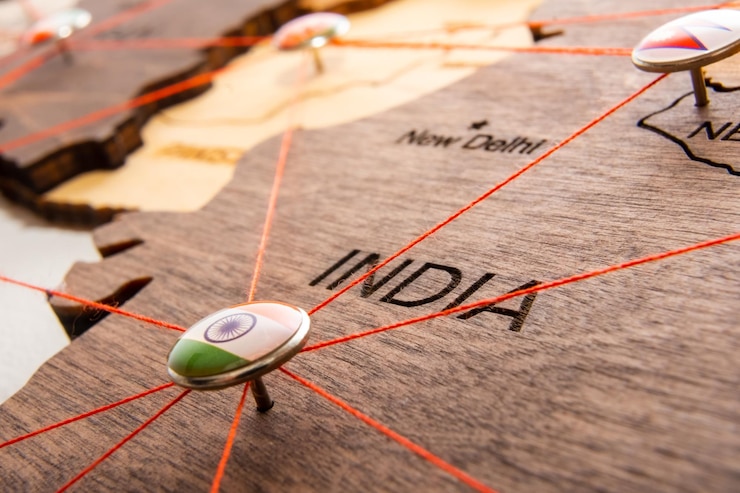As India steps into 2025, the economy finds itself at a significant crossroads. Over the past few years, India has faced multiple challenges—ranging from the impacts of the COVID-19 pandemic to global disruptions in trade and supply chains. Despite these obstacles, India’s economic outlook remains relatively positive, with the nation making significant strides towards growth and modernization. From rising GDP growth to advances in the digital economy and renewable energy, India is making its mark as an emerging economic powerhouse. In this piece, we’ll explore the current economic developments in India in 2025, highlighting key factors that are driving the economy forward.
1. GDP Growth and Economic Outlook
India’s GDP growth in 2025 is projected to be around 6.5%, reflecting a strong recovery from the economic downturn caused by the pandemic. While this is a positive development, it is still slightly lower than the pre-pandemic growth rate due to ongoing global uncertainties and domestic inflationary pressures. However, the Indian government’s focus on infrastructure, manufacturing, and digital transformation has played a crucial role in boosting economic momentum.
The growth in India is being led by increased consumption, rising private sector investments, and export performance. Key sectors such as technology, pharmaceuticals, and renewable energy are driving this growth, with a growing middle class and the government’s pro-business policies contributing to a vibrant economic environment.
2. Inflation and Monetary Policy
Inflation continues to be a concern for India in 2025. While the inflation rate has moderated after peaking in the post-pandemic years, it remains between 5-6%, primarily driven by food prices and rising energy costs. Essential items such as vegetables, pulses, and edible oils continue to push up the consumer price index (CPI), creating pressure on household budgets.
To manage inflation, the Reserve Bank of India (RBI) has maintained a cautious approach to monetary policy. Interest rates have been adjusted upward slightly to curb inflation, while also striving to keep the growth momentum intact. The future of inflation depends largely on global commodity prices, the performance of India’s agricultural sector, and how well supply chains adapt to post-pandemic changes.
3. Global Trade and Export Performance
India’s export sector in 2025 continues to show resilience, even amid global trade tensions and disruptions. The “Atmanirbhar Bharat” initiative, aimed at fostering domestic manufacturing, has helped boost India’s export competitiveness, especially in sectors like information technology (IT), pharmaceuticals, and textiles.
India’s IT services have seen a surge in demand, as businesses worldwide increasingly embrace digital solutions and automation. Agricultural exports, especially rice, spices, and seafood, continue to perform well, bolstered by the government’s focus on improving farming techniques and international trade agreements.
India has also been working on strengthening its trade partnerships. Free trade agreements (FTAs) with countries in the ASEAN region, the European Union, and the United States are expected to bolster export growth and reduce India’s dependence on traditional markets like China.
4. Labor Market and Employment Trends
In 2025, India’s labor market reflects significant changes, largely due to the accelerated shift toward digital and technology-driven jobs. While the pandemic led to job losses in sectors like retail and manufacturing, new opportunities have emerged in areas like IT, renewable energy, and the gig economy.
India has become a hub for digital and remote work, with many workers opting for flexible, freelance, or part-time employment opportunities. The rise of digital platforms in sectors such as education, healthcare, and retail has created a surge in tech-driven jobs. However, youth unemployment remains a challenge, particularly in rural regions, and addressing this gap is a critical priority for policymakers.
To address these issues, the government is focusing on skill development programs, technical education, and entrepreneurship to equip workers with the necessary tools to thrive in a rapidly evolving job market.
5. Renewable Energy and Sustainability
One of the most significant shifts in India’s economy in 2025 is the country’s commitment to renewable energy. India has set a target of achieving 50% of its total energy capacity from non-fossil fuel sources by 2030, and substantial progress has been made in this regard.
Solar energy, wind energy, and hydropower are playing an increasingly prominent role in India’s energy mix, reducing the country’s reliance on coal and oil. Large-scale solar parks, wind farms, and government-backed incentives for green energy startups are fueling this transition. India’s efforts to curb carbon emissions and move towards a low-carbon economy are expected to bring long-term environmental and economic benefits, including job creation in green industries.
International collaborations are also helping to attract investment in clean energy projects, ensuring that India is well-positioned to lead the renewable energy revolution in Asia.
6. Technological Advancements and the Digital Economy
India’s digital economy is thriving, with technology becoming an integral part of daily life. Government initiatives like Digital India have expanded internet access, promoted digital literacy, and integrated e-governance into the fabric of Indian society.
In 2025, India has become a global leader in the IT services sector, with cities like Bengaluru, Hyderabad, and Pune emerging as tech hubs. Indian software companies, such as TCS, Infosys, and Wipro, are capitalizing on the growing demand for cloud computing, artificial intelligence (AI), and machine learning services.
The fintech sector has also seen tremendous growth, with millions of Indians adopting digital payment systems and mobile banking solutions. As the government continues to encourage digital financial services, India is making significant strides towards a cashless society, which could enhance economic efficiency and financial inclusion.
7. Real Estate and Urbanization
Urbanization in India continues to accelerate in 2025, driven by population growth, rural-to-urban migration, and rising income levels. Major cities are seeing increased demand for both residential and commercial real estate, with infrastructure development playing a central role in shaping these urban landscapes.
The Indian government’s focus on affordable housing, as part of the Pradhan Mantri Awas Yojana (PMAY), has helped address housing shortages in urban centers. Additionally, the Real Estate (Regulation and Development) Act (RERA) has brought more transparency and accountability to the sector.
In the future, urban development will likely focus on smart cities and sustainable infrastructure, with a greater emphasis on green spaces, renewable energy, and efficient public transportation systems to accommodate the growing urban population.
8. Global Economic Risks and Geopolitical Challenges
India’s economy, though resilient, remains exposed to global risks. Geopolitical tensions, especially between major world powers, and global economic slowdowns can potentially disrupt trade and investment flows. Moreover, volatility in global oil prices continues to pose a challenge for India, as it remains a major importer of crude oil.
The ongoing conflict in Ukraine and shifting alliances in international trade are also risks that could impact India’s economy. Nonetheless, India’s large domestic market and its diversification of trade partners provide a cushion against such global uncertainties. The nation’s emphasis on self-reliance, through initiatives like “Make in India” and strengthening local supply chains, further enhances its economic resilience.
Conclusion
In summary, India’s economy in 2025 is characterized by robust growth, significant advances in digital transformation, and a clear shift towards sustainability. While inflation, unemployment, and global trade disruptions continue to pose challenges, India’s long-term outlook remains optimistic. With ongoing reforms, a focus on green energy, and the rise of a digital economy, India is well-positioned to navigate the complex global landscape and continue its trajectory toward becoming a global economic leader in the coming decades.







